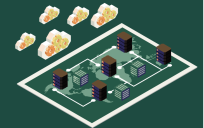This post is an excerpt from our latest GovLoop Academy 10-minute course, How to Implement the Internet of Things.
Many government organizations are already using the Internet of Things (IoT) to collect data. However, they aren’t reaping the efficiency and cost-saving rewards that they hoped for. Why?
The problem is that most organizations deploy IoT in a traditional architecture where multiple sensors – we’re talking hundreds of thousands of devices – are placed throughout a community and then connected to a centralized data center.
By connecting all of those sensors to a single data center, organizations ensure they’re receiving every byte of data. But that’s not really the point of IoT. What agencies really want from IoT is actionable data.
In these traditional architectures, organizations receive everything – including information they don’t need. Not only does that make it difficult to sift through unnecessary data to find kernels of insight; it also presents a lot of operational problems.
Given the volume and frequency of generated data, networks are likely to become overloaded and even inoperable. Cybersecurity teams will also have a hard time differentiating that continuous stream of high-volume data from intentional network attacks like distributed denials of service.
Not to mention, processing all this redundant or unimportant data will take significant storage and computing resources that agencies simply can’t afford.
Thankfully, there’s a better way to architect IoT systems that allows agencies to get the most insights into their data without over-stretching their resources.
This approach involves placing gateways between devices producing data and the central datacenter. Gateways reduce network transit time. More importantly, they regulate traffic. Rules can be implemented both at the datacenter and at the gateway to filter sensor data. With those rules in place, only meaningful messages are relayed across the network.
As a result, data centers only receive important information. That eliminates the need to process or store large volumes of unnecessary data. Plus, administrators don’t have to sift through redundant or unimportant data to find actionable insights. The gateway does that automatically.
This architecture – called computing at the edge – is a far more effective way to manage the vast array of IoT devices and systems that governments need to meet mission goals. In our recent course, How to Implement the Internet of Things, we explain how this setup works and what agencies need to get started with a better IoT strategy.






Leave a Reply
You must be logged in to post a comment.